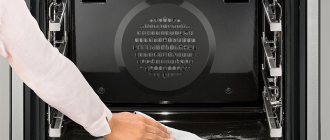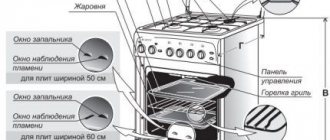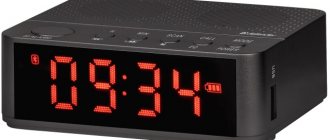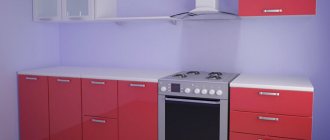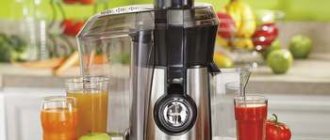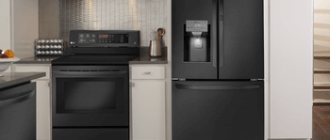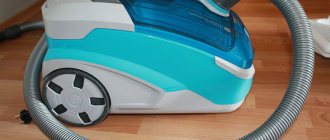It will take you at least two hours to prepare grilled duck with baked potatoes and vegetables for lunch. Not much, but it’s also worth remembering that it also takes time to clean the oven. When you cook food in the oven, fat settles on its walls and bottom. Polymerization of fat molecules and the surface occurs, which forms a thick crust. Getting rid of stuck fat is quite difficult, even with the use of high-quality detergents. If you clean the dirt with your hands, you will waste a lot of time on it. Modern ovens have three possible cleaning options, and when choosing such kitchen appliances, be sure to pay attention to this point. Cleaning in ovens is carried out through pyrolysis, catalysis and hydrolysis. Let's consider all the options in more detail.
Mine, mine
The least that manufacturers of household appliances can offer is easy-to-clean enamel and grease filters. The oven walls are coated with smooth, non-porous Easy To Clean or Granit Email enamel. All dirt can be easily wiped off by hand with a damp sponge. It is necessary to wash the oven after each use to prevent dirt from burning. It is best to do this with a soft sponge, liquid cleaning agent or without it, do not use powder - it can damage the coating. This type of cleaning is the most energy-intensive for those who cook and the cheapest for those who buy an oven. Prices for an oven with traditional cleaning start at RUB 7,000.
Easy clean enamel
The easiest option for cleaning the oven is special enamel. This glassy coating for oven walls is non-porous and therefore repels grease, dirt and water. Consequently, the splashed fat does not stick to the surface of the oven, thereby making cleaning easier. Electric ovens and gas ovens are mainly coated with easy-to-clean enamel. The purpose of this coating is not only to make it easy to clean, but also to protect the surface from aggressive influences that cause metal corrosion.
Quartz sand, feldspar and soda are used to produce enamel. When these components melt, a transparent base is formed. Adding silencers to it allows you to get shiny and beautiful enamel. All components are natural substances, so the finished enamel is environmentally friendly and hygienic.
The main advantage of easy-to-clean enamel is considered to be resistance to acids, the formation of which occurs during the heat treatment of products with a high sugar content.
The service life of the easy-to-clean enamel coating is equivalent to the service life of the oven. In addition, the coating allows you to see the inside of the oven, which greatly facilitates cleaning.
The disadvantage of this coating is the need to wash after each cooking. The surface can be wiped with a soft sponge using liquid detergents. It is not recommended to use cleaning powder as it may damage the enamel. If you follow these simple rules, your oven will last a long time.
She cooks herself, she cleans herself.
Unlike the previous enamel, enamel for catalytic cleaning is porous and rough to the touch, but causes much fewer problems with cleaning. It is porous for a reason. It is these pores that absorb contaminants, and in them the decomposition of fat into carbon, water and organic residues occurs (catalysis). To clean the oven, you do not need to turn on a special mode, spending additional time on this. Cleaning occurs directly during food preparation. The decomposition of dirt begins at a temperature of 140° C, reaching a maximum at 200° C. Thus, after turning on the oven, it will be enough to wipe it a little.
Unfortunately, the catalytic purification system has quite significant drawbacks. Not all pollution breaks down into carbon and water at once. Large grease stains can disappear in just a few cycles of turning on the oven; if you are a pedant or don’t want to wait, wash by hand. Another disadvantage: over time, the enamel loses its catalytic properties - after 4-5 years you will have to change the internal panels, or turn them over if they are double-sided. Replacing panels will cost 2-4,000 rubles. Yes, and more. Not the entire inner surface of the oven is covered with enamel with catalytic properties. The bottom of the oven and the door, as before, will have to be washed by hand. Try to choose a model with a smooth door with a minimum number of joints so that you don’t have to clean every crevice.
By the way, ovens with catalytic cleaning from different companies practically do not differ from each other in terms of cleaning quality, because... They buy enamel from its manufacturers, and there are very few of them. Instead of special enamel (or together with it), the oven may have a grease filter. If the catalytic panels need to be changed periodically, then just wash the filter, you can even do it in the dishwasher. In this case, there should be no dishes in the dishwasher, because... food debris will get into the filter and it will stop working.
It is worth mentioning a type of catalysis – ecolysis. Ovens with such a cleaning system are produced, for example, by Siemens and Bosch. The ovens of these companies are covered with EcoClean enamel, on which fat decomposition occurs at a higher temperature - 270 ° C. And the Eco- prefix emphasizes the environmental friendliness of the process.
Ovens with a catalytic cleaning system are easy to use and relatively cheap, although more expensive than ovens with traditional cleaning. For example, Ariston offers 7 models of ovens with catalysis, the price varies from 16,000 to 36,000 rubles. All models are electric, gas only provide traditional cleaning. There are 8 ovens with pyrolytic cleaning. Let's compare two randomly selected ovens of the same Luce design: 7OFK 899E PX RU/HA with pyrolysis and FK 932 CX/HA with catalysis.
| 7OFK 899E PX RU/HA with pyrolysis | FK 932 CX/HA with catalysis | |
| Number of cooking programs | 10 | 8 |
| Oven capacity | 62l | 58l |
| Electronic timer | No | Yes |
| B-B-Q | Yes | No |
| Automatic baking | Yes | No |
| Simultaneous preparation of several dishes | No | Yes |
| Grill | No | Yes |
| Automatic bread preparation | Yes | No |
| Defrosting | No | Yes |
| Deep baking tray | 1 PC | No |
In general, there are few differences. Ovens with pyrolytic cleaning have a more powerful protection system, because... cleaning occurs at very high temperatures. The oven is equipped with triple glass, door and control panel locking.
Eco-enamel
In 2004, Bosch began supplying ovens with eco-enamel. The coating promotes faster breakdown of fatty contaminants. At the same time, the service life of enamel is significantly higher than other coatings; manufacturers guarantee impeccable service for 10 years.
All types of easy-clean enamel have undeniable advantages:
- sufficiently high strength;
- resistance to mechanical damage;
- long operational period;
- resistance to high acidity and chemicals;
- ability to withstand high temperatures.
When choosing a cleaning option, you should be guided by the frequency of use of the oven. For those who use the oven extremely rarely, the ideal option would be ovens whose interiors are coated with easy-to-clean enamel. If you use the oven more frequently, you should choose a coating with a catalyst or with pyrolysis cleaning. The main thing is that cooking is a pleasure, and cleaning the oven does not cause problems.
Burn, burn clearly
Since we have given an example of an oven with pyrolytic cleaning, we will tell you more about it. Pyrolysis is the burning of fat and other contaminants at a very high temperature - 500° C. That is why the oven needs reliable protection against overheating and accidental opening of the door.
The door is locked until the temperature inside reaches 200° C. Triple glass protects the outer part of the door from overheating, but its temperature reaches 90° C - you can get burned. The oven body is made of steel, capable of withstanding repeated strong heating (remember about 500° C?) without deforming. To ensure that the side walls of the kitchen furniture in which the oven is installed do not warp from the high temperature or, God forbid, ignite, an additional cooling system for the outer surface is installed in it.
In the process of burning contaminants, an unpleasant odor is formed - an additional air purification system is needed: smoke removal directly from the oven into the ventilation; there is a special hole in the oven for this. And when various sauces burn, even toxic gases can be released (God, what are we eating) - special catalytic filters do not allow them to leave the oven. The enamel covering the inner surface of the oven should also not change its properties (not darken, for example).
To clean the oven, you must specifically turn it on. The cycle takes from 90 to 150 minutes, depending on the degree of contamination. When choosing an oven, please note that you can vary the cleaning time - this will save energy.
Of course, an oven made of such durable materials and equipped with such a powerful cleaning system cannot be cheap. Minimum price 18,000 rubles - Ariston F 1039GP.1 IX. Smeg offers ovens with pyrolytic cleaning from RUB 45,000.
Pyrolytic oven cleaning system
The pyrolytic system for removing contaminants is considered the most aggressive, but at the same time quite effective. During pyrolysis, food remains are burned to ash. This method can be called complete self-cleaning, since you do not need to wash the oven door after preparing your favorite dishes, as with catalysis. Residues of food and fat are burned under the influence of a high temperature of 500 degrees. During self-cleaning, it is impossible to open the oven door because it is locked.
Pyrolysis requires a lot of electricity, so when purchasing an oven with this type of cleaning, be sure to purchase a power cable that can withstand power up to 6 kW.
Ovens with a pyrolysis function are quite popular today; manufacturers Bosch and Gaggenau have created models in which the pyrolytic cleaning system is divided into levels. This means that the oven needs to be as hot as possible. Some of the leftover food will turn into ash at a temperature of 250–300 degrees. A level pyrolytic cleaning system is needed so that consumers can save energy, since some food residues and grease deposits are removed using a gentle method.
Advantages of pyrolysis:
- there is no need to disassemble the oven in parts, that is, take out baking sheets and grill, which could not be done when cleaning manually;
- pyrolysis is considered the most effective method of self-cleaning;
- To produce ovens with a pyrolysis system, manufacturers use high-quality material that can withstand high temperatures.
Disadvantages of pyrolysis:
- ovens with a pyrolytic cleaning system are considered the most expensive;
- if you rarely clean the oven, an unpleasant burning smell may occur during pyrolysis;
- temperature load on kitchen furniture. It is imperative to check with the seller how hot the side walls of the oven are, since built-in furniture can withstand temperatures of no more than 70 degrees.
- lack of telescopic components in some models of ovens with pyrolysis.
Hydrolysis
As the name suggests, hydrolysis is cleaning the oven using water. About half a liter of water (sometimes with a cleaning agent) is poured into a baking tray, and the oven is turned on for half an hour at a temperature of 50 ° C - 90 ° C. Steam and cleaning agent soften dirt, and they are quite easy to remove with a cloth. Strictly speaking, hydrolysis cannot be called self-cleaning of the oven, because all the main work will have to be done by you - removing fat from the surface, albeit softened. Naturally, hydrolysis is effective only if the food remains have not had time to dry out.
Let's try to figure out which method is more effective
| Pyrolysis | Catalysis | Hydrolysis | |
| Oven cost | High | Average | Low |
| The need to additionally turn on the oven | Eat | No | Eat |
| Cleaning the oven manually | No | Eat | Eat |
| Energy consumption during cleaning process | High | Average | Low |
| Frequency of use | Rarely, due to contamination | After each use of the oven | After each use of the oven |
| Risk of getting burned | Eat | No | No |
| Raising the temperature in the kitchen | Eat | No | No |
| Availability of telescopic guides for baking sheets | Not available on all models | Eat | Eat |
Of course, each cleaning method has its pros and cons. If you don’t want to manually clean every joint inside the oven (catalysis still cannot completely remove dirt), choose an oven with pyrolytic cleaning, and don’t let the additional energy costs bother you. On average, electricity consumption per hour of operation is 3-4 kW, that is, 3 hours of pyrolysis will cost about 15-20 rubles, and no manual work!
One of the advantages of catalytic cleaning is that even a gas oven can have it. Electricity consumption is significantly lower, but the door and bottom of the oven still need to be washed manually, and the catalytic panels must be changed periodically.
Even manufacturers of household appliances cannot decide which cleaning option is better. For example, Gaggenau and Miele use pyrolytic cleaning on top oven models, while Neff and Kuppersbusch use catalytic cleaning. When choosing a cleaning method, you can be guided by the following recommendations (from Miele): if you use the oven once a week, catalysis is enough; if more often, pyrolysis is needed, because it is more effective.
Summary table of oven cleaning methods
| Comparison parameter | Manual | Steam | Catalytic | Pyrolytic |
| Efficiency | low | average | average | high |
| Energy consumption | No | low | No | high |
| Need to clean manually | Yes | Yes | Yes | No |
| Turning on the oven for cleaning | No | Yes | No | Yes |
| Price | low | average | average | high |
| Increased temperature in the kitchen | No | No | No | Yes |
The decision is yours!
Sincerely, leading specialist V. Rakevich
Recommendations
care for your oven :
- Removed baking sheets can be washed in the dishwasher rather than by hand.
- Do not use abrasive powders or hard brushes for cleaning, as they can damage the surface.
- Purchased household cleaning products must be used in accordance with the instructions for the specific product.
- Purchased products are used one at a time, without mixing them with each other.
- When choosing a cleaning product, it is better to give preference to gel or liquid consistencies, as they have less risk of damaging the surface.
- To care for ovens, you should only use products that are labeled “for ovens.”
Preparation
In order for the oven to be processed without any problems, you need to prepare for the cleaning process. During cleaning, the stove must be turned off and the oven itself must not be hot. All baking sheets and pans should be removed.
Baking soda, vinegar, citric acid and lemon juice may be useful for the job. If the oven is in a neglected state, then particularly stubborn dirt must be soaked in advance.
Stained glass can be cleaned in this way:
- Apply a layer of baking soda to the contaminated areas and moisten them with water.
- Leave in this form for several hours to soften.
The soda should not be allowed to dry out or crystallize on the surface.
Advantages and disadvantages of the method
The traditional cleaning method has its strengths and weaknesses that need to be taken into account during the process.
The advantages of the method include:
- financial savings;
- no dependence on the availability of certain household chemicals;
- simplicity of the method.
The disadvantages include:
- time-consuming cleaning;
- there is a possibility of damage to the coating if the intensity of the impact is incorrectly calculated;
- cleaning products must be chosen very carefully;
- the need for separate processing of all removable and non-removable parts;
- large labor costs - without personal participation, cleaning will not happen.
Overview of cleaning products
It is difficult for a modern housewife to choose the right oven cleaner. The stores offer a wide range of different gels and sprays for removing grease and soot. The most popular means:
- Breff mousse for oven cleaning. The product does a great job even with old fat in the oven. Thanks to its thick foam, the mousse dissolves dirt. The product must be removed with a damp sponge, and then wipe the surface with a wet cloth.
- Amway for oven cleaning is in great demand. This product is easy to use and has a pleasant smell - reviews say. It quickly removes grease and effectively cleans the oven. With its help you can deal with even stubborn marks from cooking.
When working, you need to remember safety precautions. Cleaning procedures should be carried out with gloves. During work, be sure to ventilate the room. The product should be rinsed off well with running water.
It is best to apply mousse or cleaning gel and then leave it in the oven for two hours. After this, wash the surfaces thoroughly with water.
Disadvantages of the traditional method
The traditional type of oven cleaning has a number of disadvantages:
- In order to clean the oven, a person spends a lot of effort and energy. It must be remembered that traditional oven cleaning is a process that is carried out manually.
- It is necessary to wash the tray separately from the grill.
- When cleaning with a special powder, there is a risk of damaging the oven surface.
